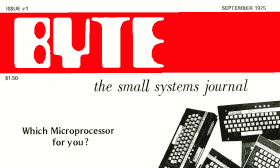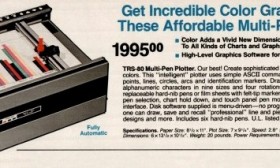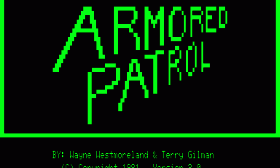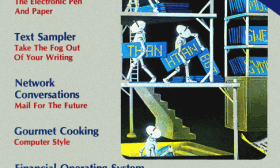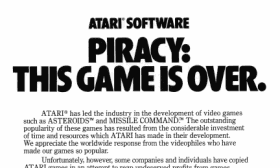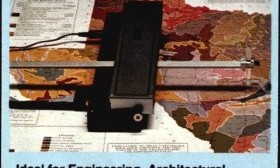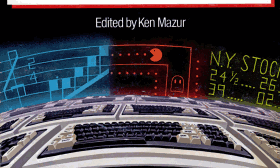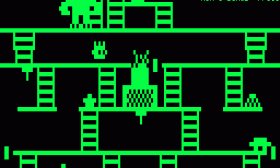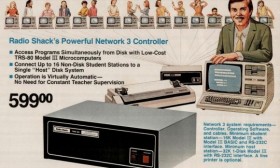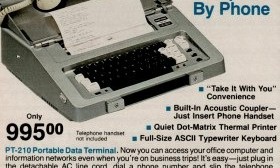BYTE: The Small Systems Journal was one of the longest running computer magazines and also one of the most popular. It was published from September 1975 to July 1998 and at one point in the 1980’s was the largest magazine in the country. In addition to the United States version, there were also twenty licensed editions of BYTE published in other countries.
BYTE was described by editor Carl Helmers in the premiere issue as “a monthly compendium of information for the owners and users of the new microcomputer systems becoming widely available at moderate cost.” It began at the start of the microcomputer revolution, even before mass-marketed computers were widely available, but also spanned into the age of the Internet and the World Wide Web.
(Read more...)
The TRS-80 Multi-Pen Plotter (catalog number 26-1191) was similar to the earlier TRS-80 Plotter/Printer (catalog number 26-1190), but offered one important new feature: the ability to print in color. Described as an “intelligent plotter,” the Multi-Pen Plotter used replaceable colored pens to print on paper or transparencies. Even at a price of $1995.00, the Multi-Pen Plotter was cheaper than many other color output alternatives available at the time. In fact, the catalog description states that the Plotter “brings an affordable price to color graphics!”
(Read more...)
Armored Patrol was one of the most popular TRS-80 games, described by Owen Linzmayer in Creative Computing as “a classic in every sense of the word.” It was distributed by Adventure International and written by Wayne Westmoreland and Terry Gilman, the first of their games for the TRS-80. Unlike their other Adventure International games, Armored Patrol was never ported to any other computers.
Armored Patrol was based on the arcade game Battlezone, released by Atari in 1980. Battlezone used vector graphics to depict a tank battle with a first-person 3‑D view, a real innovation at the time. The player controlled a tank that could rotate 360 degrees. The goal was to destroy the enemy tanks that could be anywhere on the battlefield, even behind the player. Other obstacles were pyramids, which could block the enemy tanks, and even the occasional UFO.
Here is an overview of Armored Patrol from a 1982 Adventure International catalog:
(Read more...)
SoftSide was a popular computer magazine that covered multiple computer platforms, including the TRS-80, Apple II, Atari, Commodore 64, and IBM PC. But when Roger Robitaille published the first issue in October 1978, SoftSide focused on only one computer: the TRS-80 Model I.
That first issue, which identified itself as “your BASIC software magazine,” began with this statement:
There are those who might say we’ve got rocks in our heads for starting another computer magazine in the first place. We even wondered about it ourselves—but only for a minute.
Personal computing has taken a new direction. The technological wonder of the early ‘70’s has come out of the basement workshop and into the living room. People are coming to look upon the computer less as the ultimate machine, the hobby in itself, and more as the tool, the medium, the vehicle for the real stars—our ideas and imagination.
Our intention is to publish software—and lots of it, free for the transcription. Every month we will offer programs for business, games, programs with household applications, even educational programs for children that will allow your home computer to become the educational aid we always knew it could be. Our content will be as diverse and unique as our featured program’s writers.
(Read more...)
In late 1981, Atari began running an unusual full-page advertisement titled “Piracy: This game is over.” It appeared in several computer magazines, including InfoWorld, BYTE, Creative Computing, and SoftSide. Atari also sent copies to a number of software publishers. The advertisement read:
ATARI has led the industry in the development of video games such as ASTEROIDS and MISSILE COMMAND. The outstanding popularity of these games has resulted from the considerable investment of time and resources which ATARI has made in their development. We appreciate the worldwide response from the videophiles who have made our games so popular.
Unfortunately, however, some companies and individuals have copied ATARI games in an attempt to reap undeserved profits from games that they did not develop. ATARI must protect its investment so that we can continue to invest in the development of new and better games. Accordingly, ATARI gives warning to both the intentional pirate and to the individuals simply unaware of the copyright laws that ATARI registers the audiovisual works associated with its games with the Library of Congress and considers its games proprietary. ATARI will protect its rights by vigorously enforcing these copyrights and by taking the appropriate action against unauthorized entities who reproduce or adapt substantial copies of ATARI games, regardless of what computer or other apparatus is used in their performance.
(Read more...)
The TRS-80 Digitizer (catalog number 26-1195), available in November 1981, provided a way to digitize maps, blueprints, and charts in an era before document scanners were affordable or commonly available. The Digitizer, which measured 2¼″ by 15½″ by 4¼″, cost $449.00 and connected to the TRS-80 Model I or Color Computer through the cassette port or to other TRS-80 models through the RS-232 port. (Oddly, the Model III couldn’t be connected through the cassette port like the Model I.)
The manual described the concept behind the TRS-80 Digitizer:
What exactly is a digitizer? Basically, it’s a device that describes a specific point on a sheet of paper in terms of its X-Y (Cartesian) coordinates. For example, if you didn’t have a Digitizer and you wanted to describe the location of a particular point on an 8 1/2" X 11" sheet of paper, you would need to measure how far from the left edge that point is, then how far from the top edge it is.
A digitizer does this for you. It tells you how far horizontally (the X-axis) and how far vertically (the Y-axis) that point is from the edge of the paper.
(Read more...)
Creative Computing was one of the longest running of the early microcomputer magazines, publishing from 1974 to 1985. Unlike most later microcomputer magazines, Creative Computing covered the entire range of personal computers, including the TRS-80, Atari, and Apple.
In 1983, Creative Computing Press published three books collecting computer-specific articles from the pages of Creative Computing. They targeted each book at a different computer market: The Creative Atari, The Creative Apple, and The Creative TRS-80.
The Creative TRS-80, edited by Ken Mazur with a preface by Creative Computing Associate Editor John J. Anderson, has over 100 articles and reviews from Creative Computing.
(Read more...)
Wayne Westmoreland and Terry Gilman wrote some of the best games for the TRS-80 Model I and III, including classics such as Sea Dragon and The Eliminator. When Wayne Westmoreland released all of their games to the public domain in 1995, TRS-80 owners received an unexpected treat: Donkey Kong, a previously unreleased TRS-80 game.
Donkey Kong was based on the Nintendo arcade game of the same name from 1981. The hero of the Nintendo game is a carpenter named Mario (who later became better known in the game Mario Bros). The goal is to rescue Mario’s girlfriend Pauline from the marauding Donkey Kong. Mario needs to reach Pauline at the top of the screen, all the while dodging barrels thrown by Donkey Kong. Other obstacles include conveyor belts, elevators, and fireballs.
(Read more...)
The Radio Shack Network 3 Controller (catalog number 26-1212) was a networking system designed for use in classrooms. First appearing in the 1983 catalog, the Network 3 Controller cost $599.00. Unlike the earlier Network I> and Network 2 Controllers, which worked with more than one type of TRS-80 computer, the Network 3 Controller only supported the Model III or Model 4 in Model III mode.
From the description in a 1983 Radio Shack catalog:
The Network 3 Controller enables up to 16 Model III student stations to choose from lessons stored on a teacher’s “host” system. This frees the instructor from repeatedly loading programs into individual stations. And scores are automatically stored on the host disk for later review as lessons that generate student record keeping are completed. The Network 3 also allows computer science students to learn Disk BASIC on a non-disk Model III. That means you get the features of a disk-equipped computer, but at about half the price!
(Read more...)
The TRS-80 PT-210 Portable Terminal (catalog number 76-1001) was a mobile dumb terminal that provided a way for travelers to access remote computers while on the road. Introduced by Radio Shack in late 1982 for a price of $995.00, the PT-210 was promoted with the slogan “Now there’s a TRS-80 you can take with you on business trips!”"
The PT-210 weighed 15 pounds and came in a briefcase-style case. It contained a full-size 53-key keyboard, an acoustic coupler that communicated at 110 or 300 baud, and a “whisper-quiet” thermal printer. The catalog description stated:
(Read more...)
